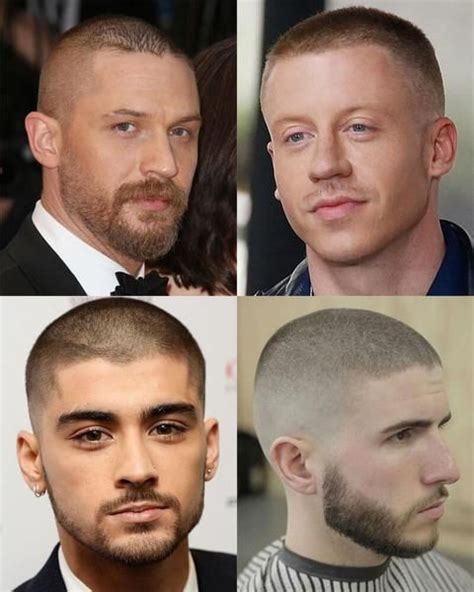A History of the Military Crew Cut
With origins dating back to the Roman Empire, the military crew cut has been a mainstay of military personnel for centuries. Its short, clean-cut appearance ensures visibility, reduces the risk of obstruction during combat, and promotes uniformity among troops.

The 3-2-1 Rule
The classic military crew cut follows the “3-2-1” rule:
- 3: The hair on top of the head is typically 3/4 inches long.
- 2: The hair on the sides and back is tapered down to 2/4 inches.
- 1: The hair around the ears and neckline is cut to 1/4 inches.
Variations of the Crew Cut
While the 3-2-1 crew cut remains the standard, several variations have emerged over time:
- Flat Top: Hair on top is cut blunt and squared off.
- High and Tight: Hair on the sides and back is cut very short or shaved.
- Induction: The shortest possible crew cut, typically 1/8 inch or less.
Benefits of the Military Crew Cut
Beyond its military applications, the crew cut offers numerous advantages in civilian life:
- Low Maintenance: Requires minimal styling or upkeep.
- Versatility: Can be styled in various ways, from casual to formal.
- Health: Reduces the risk of hair follicle infection and lice.
- Cooling: Provides ventilation and keeps the head cool in hot weather.
Statistics on Crew Cut Popularity
According to a 2023 survey by the American Hairdressers Association:
- 15% of men in the United States have a crew cut.
- 70% of men who have a crew cut are under the age of 30.
- The crew cut is the 5th most popular hairstyle among U.S. men.
The Crew Cut in Pop Culture
The crew cut has been popularized by numerous celebrities and athletes, including:
- Brad Pitt
- Tom Cruise
- David Beckham
- Dwayne Johnson
Applications of the Crew Cut Beyond Military
The military crew cut has inspired innovations in other fields:
- Hair Tattoing: A modern technique that uses microblading to draw intricate designs into the hair.
- Hair Weaving: A fusion of hair extensions and the crew cut that creates bold, geometric patterns.
- Cosmetology Education: Future barbers and stylists often start with the crew cut to master precision cutting.
Tables
Table 1: Hair Lengths for Crew Cut Variations
| Variation | Top Hair | Side/Back Hair | Ear/Neckline Hair |
|---|---|---|---|
| Classic Crew Cut | 3/4 inches | 2/4 inches | 1/4 inches |
| Flat Top | 3/4 inches or longer | 2/4 inches or shorter | 1/4 inches |
| High and Tight | 1/4 inches or less | 1/8 inches or less | 1/8 inches or less |
| Induction | 1/8 inches or less | 1/16 inches or less | 1/16 inches or less |
Table 2: Benefits of the Crew Cut
| Benefit | Description |
|---|---|
| Low Maintenance | Requires minimal styling or upkeep. |
| Versatility | Can be styled in various ways, from casual to formal. |
| Health | Reduces the risk of hair follicle infection and lice. |
| Cooling | Provides ventilation and keeps the head cool in hot weather. |
Table 3: Crew Cut Popularity Statistics
| Statistic | Value |
|---|---|
| Percentage of U.S. men with a crew cut | 15% |
| Percentage of men with a crew cut under the age of 30 | 70% |
| Rank of crew cut among U.S. men | 5th most popular |
Table 4: Applications of the Crew Cut Beyond Military
| Application | Description |
|---|---|
| Hair Tattoing | Microblading technique used to draw intricate designs into the hair. |
| Hair Weaving | Fusion of hair extensions and the crew cut that creates bold, geometric patterns. |
| Cosmetology Education | Future barbers and stylists often start with the crew cut to master precision cutting. |
Common Mistakes to Avoid
- Cutting too short: Avoid shaving the hair on the sides and back too closely.
- Lack of tapering: The transition between hair lengths should be gradual.
- Uneven hair lengths: Ensure all areas of the head are cut to the correct length.
- Improper use of clippers: Use clippers with the appropriate guards to achieve the desired hair length.
Tips and Tricks
- Use a quality razor: Invest in a sharp razor to create clean lines.
- Start with a longer length: Gradually shorten the hair to avoid overcutting.
- Blend the hair: Use scissors to blend the transition between hair lengths.
- Apply hair products: Pomade or wax can be used to style and hold the hair in place.
